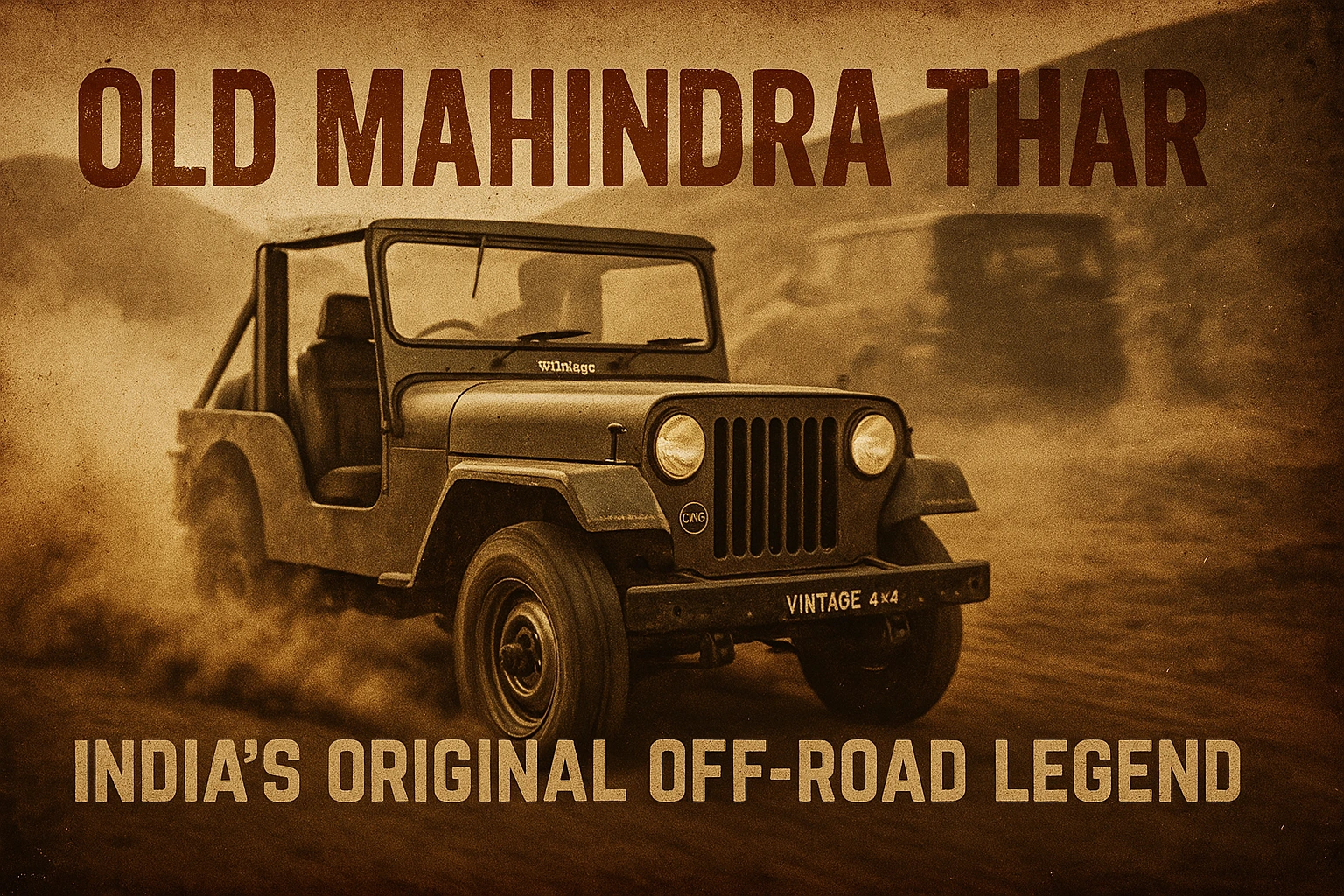If you’re an off-road enthusiast or a fan of rugged SUVs, you’ve probably heard of the legendary old Mahindra Thar. From dusty trails to muddy riverbanks, the Thar carved out its place in Indian automotive history.
Before the modern, tech-packed version took over in 2020, the first-generation Thar (2010-2020) was already a beast in its own right. This blog takes a deep dive into what made the old Mahindra Thar a cult favorite and why it continues to have a loyal fan base.
So, what made the old Thar so special? Let’s dive into its design, performance, off-road prowess, and enduring legacy.
The Origins of the Old Mahindra Thar:-
The Mahindra Thar made its debut in 2010, inspired heavily by Mahindra’s earlier Jeep-based models like the MM540 and CJ series. With its classic boxy design, open-top appeal, and no-nonsense functionality, the Thar instantly clicked with hardcore adventurers. Built primarily for off-roaders and rural users, the old Thar was all about function over form.
Unlike today’s feature-loaded SUVs, the pre-2020 Mahindra Thar was a no-nonsense, rugged machine that prioritized capability over comfort. Even after its discontinuation, it remains a favorite among off-road purists.
1. Design & Build: Pure, Unapologetic Ruggedness
The old Thar wasn’t about sleek curves or fancy styling—it was function over form.
The design of the old Thar screamed ruggedness. With its round headlamps, slatted grille, and exposed wheel arches, it looked like it was ready to conquer the jungle. It didn’t care about sleek curves or chrome accents. This SUV was for those who believed in substance over style.
Key Design Highlights:
- Boxy, Jeep-like silhouette with a short wheelbase for better maneuverability.
- Removable soft-top or hardtop, giving it an open-air driving experience.
- Body-on-frame construction—built to handle the toughest terrains.
- High ground clearance (180mm+) to tackle rocks, mud, and water crossings effortlessly.
Unlike modern SUVs with monocoque designs, the Thar’s ladder-frame chassis made it nearly indestructible off-road.
Why It Still Matters Today?
Many off-road enthusiasts prefer the old Thar’s simplicity over the new Thar’s refined design. Its lightweight body and rugged build make it perfect for hardcore trail riding.
2. Engine & Performance:
The old Thar wasn’t a speed demon, but it had enough grunt to climb mountains.
Paired with a 5-speed manual transmission and a capable 4×4 drivetrain, the Thar was born for the wild. The low-ratio transfer case and solid axles made it nearly unstoppable off-road. Whether you were tackling mountain trails or wading through slushy paths, the old Thar had your back.
Engine Options:
| Engine | Power | Torque | Best For |
|---|---|---|---|
| 2.5L CRDe Diesel | 105 BHP | 247 Nm | Best balance of power & efficiency |
| 2.5L DI Turbo Diesel | 63 BHP | 182 Nm | Basic, low-cost off-roading |
Transmission & Drivetrain:
- 5-speed manual gearbox (smooth but not refined).
- 4×4 system with manual shift-on-the-fly (2H, 4H, 4L modes).
- Low-range gearing for extreme off-roading.
Fuel Efficiency?
Don’t expect miracles—the old Thar returned 10-12 kmpl (diesel), which was decent for a 4×4 of its time.
3. Off-Road Capabilities: Where the Thar Truly Shone
This is where the old Thar outshone most SUVs in India.
Why It Was an Off-Road Beast?
✔ Mechanical Differential Lock (in some variants) for better traction.
✔ Short Wheelbase – Easier to navigate tight trails.
✔ High Approach & Departure Angles – No fear of scraping on rocks.
✔ Leaf Spring Suspension (later upgraded to coils) – Tough but bumpy ride.
Real-World Performance:
- Rock Crawling? Excellent.
- Mud & Sand? Dominated with proper tires.
- Water Wading? Could handle moderate depths (no snorkel stock).
Compared to New Thar?
The new Thar (2020 onwards) has better comfort and tech, but the old Thar’s raw mechanical feel is unmatched.
4. Interior & Comfort: Basic But Honest
If you expected luxury, the old Thar wasn’t for you.
What Did You Get?
- Plastic-heavy dashboard (durable but not premium).
- Bench-style seating (later models got individual seats).
- No power windows or touchscreen (pure analog experience).
- Minimal sound insulation – You heard every engine roar.
Why Enthusiasts Loved It?
It was a driver’s machine—no distractions, just pure driving pleasure.
5. Pros & Cons: Should You Still Buy an Old Thar?
✅ Pros:
✔ Unmatched Off-Road Ability – One of India’s best 4×4 SUVs.
✔ Easy & Cheap to Maintain – Simple mechanics, low repair costs.
✔ High Resale Value – Still in demand among off-roaders.
✔ Customization Potential – Great for modifications.
❌ Cons:
✖ Uncomfortable on Highways – Bumpy ride, noisy cabin.
✖ Lacks Safety Features – No ABS or airbags in early models.
✖ Poor Fuel Efficiency – Thirsty compared to modern SUVs.
6. Old Thar vs. New Thar: Which One Should You Choose?
| Feature | Old Thar (Pre-2020) | New Thar (2020+) |
|---|---|---|
| Design | Rugged, basic | Modern, stylish |
| Comfort | Minimal | Improved seats, AC, infotainment |
| Off-Roading | Raw, mechanical | More refined but slightly softer |
| Safety | Basic | ABS, Airbags, ESC |
| Price (Used) | ₹4-8 Lakhs | ₹10-18 Lakhs |
Who Should Buy the Old Thar?
- Hardcore off-roaders who want a mod-friendly, no-frills 4×4.
- Budget buyers looking for a cheap yet capable adventure SUV.
Who Should Go for the New Thar?
- Those who want better comfort, safety, and daily usability.
7. The Old Thar’s Legacy & Why It Still Matters
Even after being discontinued, the pre-2020 Thar has a dedicated fanbase. Many off-road clubs still prefer it for:
- Modification potential (lift kits, bigger tires, engine swaps).
- Lightweight & ruggedness (better for extreme trails).
- Affordable ownership (cheaper than the new Thar).
Is the Old Thar a Good Used Buy Today?
✅ Yes, if:
- You want a pure off-roader.
- You’re okay with basic comforts.
- You plan to modify it for trails.
❌ No, if:
- You need a daily driver with comfort.
- You want modern safety features.
Why Enthusiasts Still Love the Old Thar?
Even with the launch of the new-gen Thar, the old version continues to have a strong fan base. Many purists argue that the old Mahindra Thar has more character. Its rawness, simplicity, and pure mechanical feel offer an unmatched driving experience.
- Collectors, off-roaders, and modders all seek it for different reasons:
- Collectors love its Jeep-inspired heritage
- Off-roaders appreciate its proven trail performance
- Modders use it as a blank canvas for wild builds
Final Verdict: The Old Thar – A True Off-Road Legend
The old Mahindra Thar (2010-2020) wasn’t just a vehicle — it was a lifestyle. If you’re someone who values raw power, simple mechanics, and serious off-road prowess, the old Thar might just be your dream ride. Sure, it wasn’t perfect, but it didn’t need to be. It did what it was built to do — and it did it exceptionally well.
Looking to buy a used Mahindra Thar? Or maybe planning a restoration project? Either way, the old Thar deserves a serious look.
Looking for a used Thar? Check for:
✔ Engine condition (CRDe preferred).
✔ 4×4 functionality (test low-range).
✔ Rust or accident history.
FAQs About the Old Mahindra Thar:-
Q: Is the old Thar good for daily use?
A: Not ideal—it’s loud, bumpy, and lacks modern comforts. Best as a weekend off-roader.
Q: What’s the best engine in the old Thar?
A: The 2.5L CRDe (105 BHP) is the most powerful and reliable.
Q: Can you modify the old Thar easily?
A: Absolutely! Lift kits, off-road tires, and snorkels are popular upgrades.
Q: How much does a used old Thar cost?
A: Prices range from ₹4-8 lakhs, depending on condition and model year.
Q: Does the old Thar have ABS or airbags?
A: Early models lacked these, but later versions (2015+) had basic safety features.
Q: What are the common issues in the old Thar?
A: Look out for rust, clutch wear, and 4×4 system maintenance.

Automotive industry analyst with 3+ years of experience dissecting market trends, emerging technologies, and consumer insights. His expertise fuels data-driven perspectives on swagatswork.com, empowering professionals to navigate the evolving automotive landscape.
